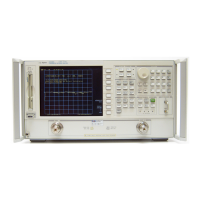4-8 Chapter4
Reading Analyzer Data
Trace-Data Transfers
Trace-Data Transfers
Transferring trace-data from the analyzer using an instrument controller can be divided
into three steps:
1. Allocating an array to receive and store the data
2. Commanding the analyzer to transmit the data
3. Accepting the transferred data
Data residing in the analyzer is always stored in pairs for each data point (to accommodate
real/imaginary pairs). Hence, the receiving array must be two elements wide, and as deep
as the number of points in the array being transferred. Memory space for the array must
be declared before any data can be transferred from the analyzer to the computer.
As mentioned earlier, the analyzer can transmit data over GPIB in five different formats.
The type of format affects what kind of data array is declared (real or integer), because the
format determines what type of data is transferred. Programming examples of data
transfers using different formats are discussed in “Measurement Data Transfer Examples”
on page 7-56. For information on the various types of data that can be obtained (raw data,
error-corrected data, etc.), see “Data Levels” on page 5-6.
For information on transferring trace-data by selected points, see “Limit Line and Data
Point Special Functions” on page 7-126.
NOTE “Example 7F: Reading ASCII Disk Files to the Instrument Controller's Disk
File” on page 7-118 explains how to access disk files from a computer.

